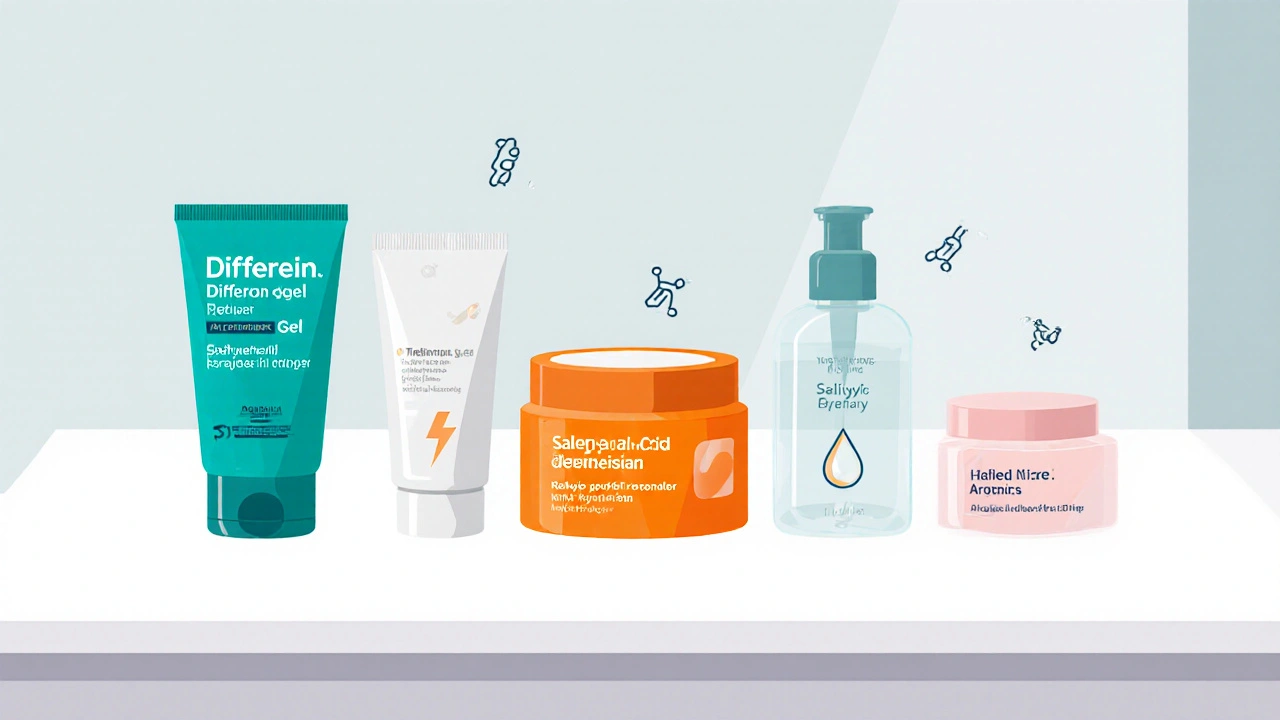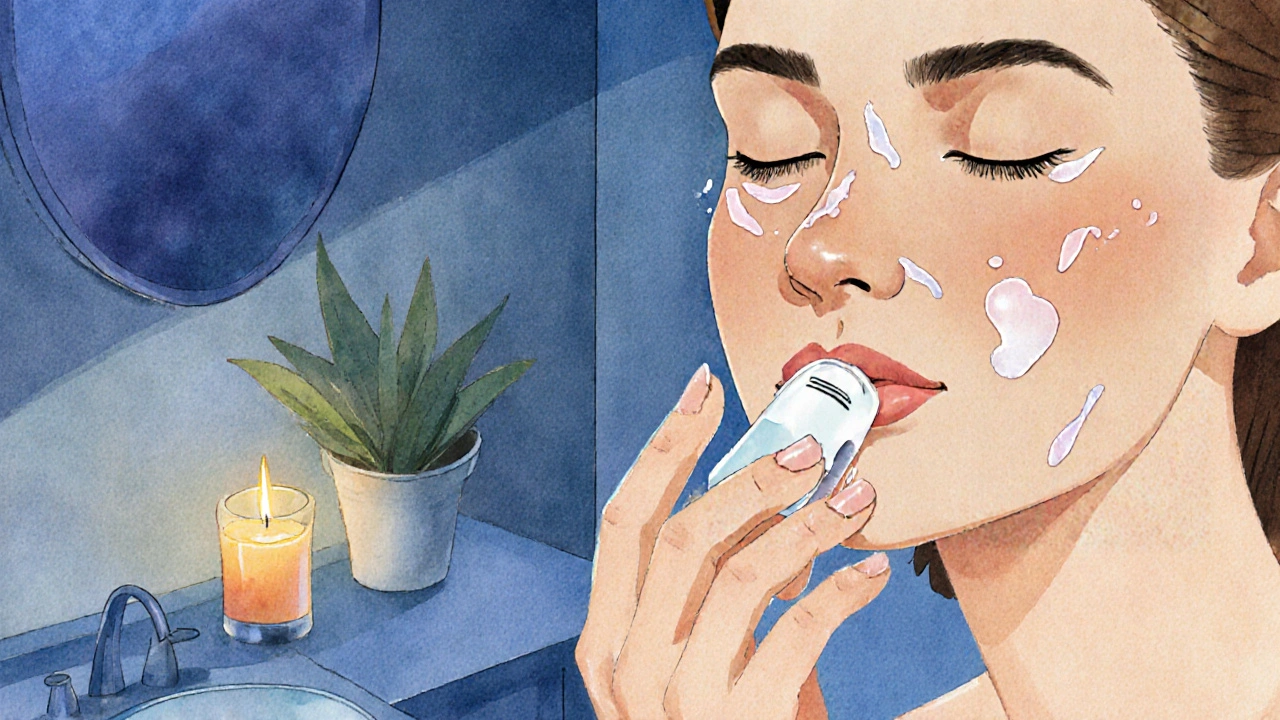Acne Treatment Comparison Tool
Your Skin Profile
Treatment Recommendations
Enter your skin profile and click "Find Best Treatment" to get personalized recommendations.
How This Tool Works
This tool evaluates your skin profile against key factors such as acne severity, skin sensitivity, budget constraints, and additional concerns like hyperpigmentation or anti-aging needs. Based on these inputs, it recommends the most suitable acne treatment from our comparison table, including Differin (Adapalene).
Acne can feel like a stubborn roommate-you try to ignore it, but it keeps showing up. With a shelf full of creams, gels, and pills, choosing the right one can be overwhelming. One product that’s been getting a lot of buzz is Differin, the over‑the‑counter brand name for the retinoid Adapalene. It promises fewer side‑effects than prescription options while still delivering solid results. But how does it really stack up against other acne workhorses? This guide breaks down the science, compares the top alternatives, and helps you decide which treatment fits your skin type and lifestyle.
What makes Differin (Adapalene) different?
Differin is a third‑generation synthetic retinoid that targets the same skin‑cell turnover pathways as older retinoids like tretinoin, but with a gentler irritation profile. It binds selectively to retinoic‑acid receptors (RAR‑β and RAR‑γ), speeding up the shedding of dead skin cells and preventing clogged pores. Because its molecular structure is more stable, it resists oxidation and stays effective even when exposed to light or air. The result? A once‑daily gel that clears comedones with less redness and peeling for many users.
Common acne alternatives you’ll encounter
Before diving into the side‑by‑side comparison, let’s introduce the most frequently recommended alternatives. Each has its own mechanism and ideal use case.
- Tretinoin - a first‑generation retinoic acid that’s the gold standard for both acne and anti‑aging. Prescription‑only in most countries.
- Benzoyl Peroxide - an antibacterial agent that killsPropionibacterium acnes and reduces inflammation. Available OTC in concentrations from 2‑10%.
- Salicylic Acid - a beta‑hydroxy acid (BHA) that dissolves oil‑clogged pores. Common in cleansers and leave‑on toners.
- Azelaic Acid - a naturally derived dicarboxylic acid that reduces keratin production, kills acne‑causing bacteria, and brightens post‑inflammatory hyperpigmentation.
- Alpha Hydroxy Acid (AHA) - primarily glycolic or lactic acid, used for surface exfoliation and texture improvement.

Side‑by‑side comparison
| Attribute | Differin (Adapalene) | Tretinoin | Benzoyl Peroxide | Salicylic Acid | Azelaic Acid |
|---|---|---|---|---|---|
| Mechanism | Retinoid - normalizes follicular epithelium | Retinoic acid - increases cell turnover | Oxidizing bactericide - eliminates P. acnes | Beta‑hydroxy acid - lipophilic exfoliant | Dicarboxylic acid - anti‑inflammatory & antibacterial |
| Prescription status (US) | OTC (0.1% gel) | Prescription | OTC (2‑10%) | OTC (0.5‑2%) | Prescription (15‑20%) - OTC (10% cream in some regions) |
| Typical strength | 0.1% gel | 0.025%‑0.1% cream | 2.5%‑10% gel/cream | 0.5%‑2% liquid | 15%‑20% cream or gel |
| Best for | Mild‑to‑moderate comedonal acne, low irritation tolerance | Moderate‑to‑severe inflammatory acne, anti‑aging | Inflammatory papules, rapid bacterial reduction | Blackheads & oily skin, gentle daily use | Rosacea‑prone skin, post‑acne marks |
| Common side‑effects | Dryness, mild peeling, occasional redness | Significant peeling, erythema, photosensitivity | Dryness, bleaching of fabrics, possible irritation | Stinging, mild dryness | Burning, tingling, rare allergic reaction |
| Price (US, 30‑day supply) | ~$15‑$20 | ~$30‑$70 (generic) or higher for brand | ~$10‑$25 | ~$8‑$15 | ~$25‑$45 (prescription) or $15‑$30 OTC |
How to choose the right option for your skin
Every acne regimen is a balance of efficacy, tolerability, and lifestyle. Here are the decision points most people weigh.
- Severity: If you’re dealing mainly with blackheads and occasional whiteheads, a BHA like salicylic acid may be enough. For persistent inflammatory lesions, a retinoid (Differin or tretinoin) or benzoyl peroxide often delivers faster results.
- Skin sensitivity: Those with eczema‑prone or very dry skin tend to react badly to high‑strength tretinoin or benzoyl peroxide. Differin’s milder irritation profile makes it a safer first line for sensitive users.
- Budget & access: Prescription drugs add doctor visits and higher out‑of‑pocket costs. Differin’s OTC status lets you start a regimen without a prescription, saving both time and money.
- Additional concerns: If hyperpigmentation is a major worry, azelaic acid offers dual benefits-acne control plus brightening. If you also want anti‑aging effects, tretinoin tops the list.
In practice, many dermatologists recommend a “core + adjunct” approach: a retinoid (Differin or tretinoin) as the backbone, plus a secondary agent like benzoyl peroxide or azelaic acid to tackle specific symptoms.
Practical tips for using Differin effectively
If you’ve decided to give Differin a try, follow these steps to maximize benefit and keep irritation low.
- Start slow: Apply a pea‑size amount once every other night for the first two weeks. This helps your skin build tolerance.
- Prep with a gentle cleanser: Use a sulfate‑free, pH‑balanced cleanser. Rinse with lukewarm water and pat dry-no rubbing.
- Moisturize before and after: A lightweight, non‑comedogenic moisturizer (e.g., ceramide‑based) creates a barrier that reduces dryness.
- Sun protection is mandatory: Retinoids increase photosensitivity. Apply broad‑spectrum SPF30+ every morning, even on cloudy days.
- Avoid overlapping actives: Skip other strong exfoliants (AHAs/BHAs) on the nights you use Differin. If you need both, alternate days.
Consistency is key. Most users see noticeable improvement in 6‑8 weeks, but you won’t see the full effect until 12‑16 weeks.

When to seek professional help
If you experience any of the following, book a dermatologist appointment:
- Severe redness, swelling, or pain that doesn’t improve after a few weeks.
- Acne that worsens despite consistent use of an OTC regimen.
- Signs of infection-pus, fever, or spreading lesions.
- Persistent post‑inflammatory hyperpigmentation that interferes with confidence.
A dermatologist can prescribe stronger retinoids, hormonal therapies, or isotretinoin if needed, and can tailor a combination that addresses your unique skin chemistry.
Frequently Asked Questions
Can I use Differin if I’m pregnant?
Adapalene is classified as Category C, meaning animal studies have shown risk but there are no well‑controlled studies in humans. Most doctors advise avoiding retinoids during pregnancy unless the potential benefit outweighs the risk. Discuss alternatives like azelaic acid or benzoyl peroxide with your clinician.
How long does it take to see results with Differin?
Most users report a reduction in new lesions within 4‑6 weeks, but the full clearing effect can take 12‑16 weeks. Patience and regular use are essential.
Is it safe to combine Differin with benzoyl peroxide?
Yes, but it’s best to apply them at different times. For example, use benzoyl peroxide in the morning and Differin at night. This reduces the chance of excessive irritation.
Can men use Differin, or is it only for women?
Acne doesn’t discriminate, and neither does Differin. Men can use it just as effectively. The only consideration is that men might have thicker skin, so they may tolerate a slightly higher frequency.
What’s the biggest drawback of Differin compared to tretinoin?
While Differin is gentler, it can be slower in treating severe inflammatory acne. Tretinoin’s stronger RAR‑α activation often clears deep cystic lesions faster, but at the cost of higher irritation.
Key Takeaways
- Differin offers a balanced mix of efficacy and low irritation, ideal for mild‑to‑moderate comedonal acne.
- For more aggressive inflammatory acne, tretinoin or benzoyl peroxide may provide quicker results.
- Combine a retinoid with a secondary agent (e.g., azelaic acid) to target multiple acne pathways.
- Start Slowly, moisturize, and protect with SPF to keep side‑effects minimal.
- Seek a dermatologist if your acne worsens, you experience severe irritation, or you’re pregnant.






Gary Levy
If you’re just starting out with retinoids, think of Differin as a gentle gateway; it won’t burn your face like some of the older formulas. The key is consistency and patience, not expecting overnight miracles. Pair it with a simple moisturizer and sunscreen, and you’ll likely see a steady decline in those pesky comedones.
sourabh kumar
i tried it and the gel felt kinda slick on my skin it didn’t sting much but i still got a bit of dryness after a week i think it’s fine for most people
Christian Miller
One must consider the broader context within which pharmaceutical products are promoted, especially when major corporations dominate the market. The subtle coercion embedded in over‑the‑counter branding can mask regulatory oversight deficiencies. Consequently, consumers should remain vigilant regarding the provenance and long‑term implications of seemingly benign topical agents.
NORMAND TRUDEL-HACHÉ
Honestly the whole Differin hype feels overblown when you compare it to a classic BHA routine.
AJIT SHARMA
From a true Indian perspective, why waste money on a foreign brand when local salicylic solutions work just as well and support our own manufacturers.
Neber Laura
This so‑called “balanced mix” is just marketing fluff; the real issue is how the industry pushes retinoids without proper warning about hidden side effects.
Karen Nirupa
It is commendable that the article delineates a structured approach to selecting acne therapies, thereby facilitating informed decision‑making for readers across diverse dermatological profiles.
Quinn Comprosky
I appreciate the thoroughness of the guide; the step‑by‑step protocol for incorporating Differin into a regimen is especially useful for newcomers. Remember to introduce the product gradually to allow the skin barrier to adapt, and always follow up with a non‑comedogenic moisturizer. Consistency over several weeks is essential, as the therapeutic benefits manifest gradually. Additionally, monitoring for any signs of excessive irritation will help you adjust usage frequency before complications arise.
Thomas Ruzzano
Yo, that advice is solid but don’t forget that a dash of humor and a pinch of boldness can make the whole routine feel less like a chore and more like a rite of passage!
Dan Tenaguillo Gil
When selecting an acne treatment, the first consideration should always be the individual’s skin type and sensitivity level.
Differin offers a unique balance between efficacy and tolerability, especially for those who have experienced irritation with stronger retinoids.
Its molecular stability allows it to remain active even after exposure to light, which is a technical advantage over many over‑the‑counter alternatives.
However, this does not mean it is universally suitable; patients with extremely oily skin may find that a dash of oil‑controlling agents is necessary.
A stepwise approach, beginning with a low frequency application, helps the epidermis acclimate without triggering excessive dryness.
In clinical practice, we often combine Differin with a ceramide‑rich moisturizer to reinforce the skin barrier.
Sun protection is non‑negotiable, as retinoids can increase photosensitivity, and a broad‑spectrum SPF30 or higher should be applied each morning.
For patients who also contend with post‑inflammatory hyperpigmentation, pairing Differin with azelaic acid in the morning can address both concerns synergistically.
It is important to avoid overlapping strong exfoliants, such as high‑percent AHAs, on the same night to prevent cumulative irritation.
If breakthrough acne occurs, a short course of benzoyl peroxide may be introduced on alternate evenings, taking care to monitor for dryness.
Patients should be counseled that visible improvement typically emerges after six to eight weeks, with full results manifesting by twelve to sixteen weeks.
Patience is a virtue in dermatology; premature discontinuation often leads to suboptimal outcomes and frustration.
The cost factor of Differin, generally ranging between fifteen and twenty dollars for a month’s supply, makes it an accessible option compared with many prescription retinoids.
Nevertheless, insurance coverage and regional pricing variations can affect affordability, so clinicians should discuss alternatives when necessary.
Overall, the therapeutic profile of Differin positions it as a solid first‑line agent for mild to moderate comedonal acne, especially in patients who prioritize a lower irritation risk.
By adhering to a disciplined routine and seeking professional guidance when needed, most users can achieve a clearer complexion without resorting to more aggressive systemic therapies.
Tiffany Owen-Ray
Think of Differin as the steady teammate in a marathon; you won’t see a sprint finish line, but over weeks you’ll notice the pace improving, the skin becoming smoother, and breakouts receding. Pair it with a gentle, fragrance‑free moisturizer and you’ll keep the barrier intact while the retinoid does its work. If you ever feel the dryness creeping in, a brief pause or a night‑off schedule can reset tolerance without derailing progress. Celebrate the small milestones-fewer blackheads, clearer pores-because those add up to the bigger victory of a healthier complexion.
Jill Brock
This regimen is a total game‑changer for my skin.
Ellie Chung
Whoa, you nailed it! The way you broke down each step feels like a backstage pass to flawless skin.
Sophia Simone
While the article presents a harmonious view of Differin, one must scrutinize the underlying assumptions that OTC retinoids are inherently superior to prescription alternatives; the data often omits longitudinal safety analyses.
Juan Sarmiento
Your encouragement truly lifts the community spirit; keep sharing those practical tips and we’ll all march toward clearer skin together.
Patrick McVicker
Thx for the info, really helpful! :)
Liliana Phera
Philosophically speaking, the pursuit of clear skin mirrors the quest for inner clarity; when we assault the surface with aggressive actives, we must simultaneously cultivate patience and self‑respect.
Dean Briggs
In my experience, integrating Differin into a comprehensive skincare protocol is akin to orchestrating a symphony; each component-cleanser, moisturizer, sunscreen-plays a distinct instrument that must harmonize. Begin with a gentle, sulfate‑free cleanser to remove excess sebum without stripping natural oils. Follow with a pea‑sized amount of Differin applied to dry skin, allowing it to absorb fully before sealing the barrier with a ceramide‑rich moisturizer. Sun protection cannot be overstated; a broad‑spectrum SPF30 or higher shields the renewed epidermis from UV‑induced damage, which can otherwise counteract the retinoid’s benefits. When you notice initial dryness or mild peeling, resist the urge to over‑moisturize or double‑dose; instead, incorporate “rest days” where you skip the retinoid and focus solely on hydration and protection. Over a period of twelve to sixteen weeks, many users report a noticeable reduction in comedones, smoother texture, and a diminution of post‑inflammatory hyperpigmentation. Should your acne persist or evolve, consider a consultation with a dermatologist to explore adjunctive therapies such as benzoyl peroxide or azelaic acid, which can be layered strategically without overwhelming the skin. Ultimately, consistency, patience, and an attentive mindset are the keystones of success in any acne‑fighting journey.